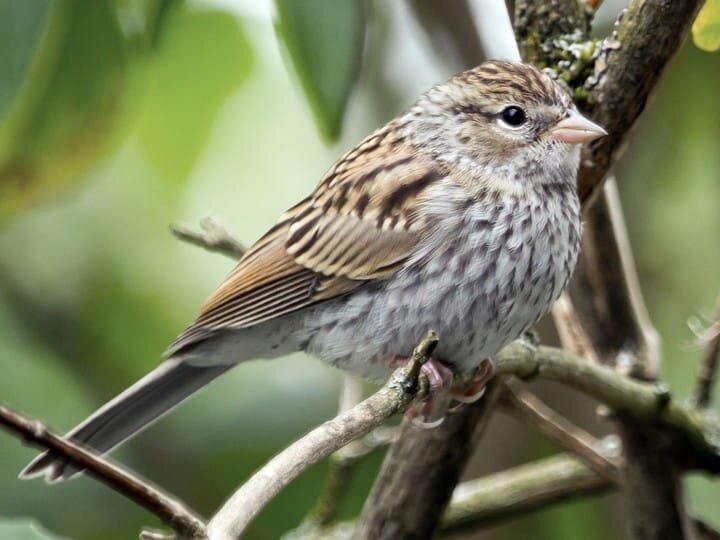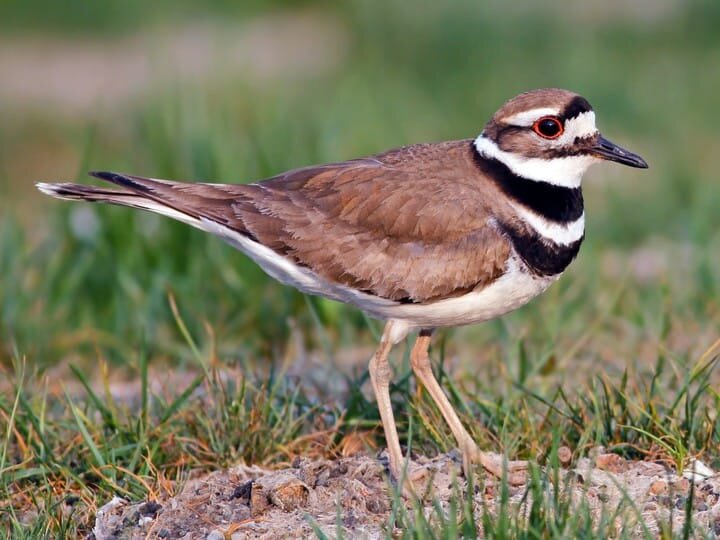Week 4: Advanced Low Elevation
Scroll down to study the birds by sight and sound, and then take the quiz.
Chipping Sparrow, Orange-crowned Warbler, Killdeer, Cedar Waxwing, California Quail, Belted Kingfisher









Orange-crowned warbler
Bird Code: OCWA
Identify this bird by…
Thin, pointy bill
Yellow-olive overall with faint eye line
Yellow under-tail coverts
Males and females look the same (not dimorphic)
Look for…
Behavior - Forage in dense shrubbery and low trees. They tend to be quiet and unobtrusive, although their low foraging habits can help you spot them. They often give a high, faint contact call while foraging.
Listen for…
Song: Males sing a trilling song of sweet, clear notes. The song can remain on a single pitch or it can rise slightly in the middle and end on a distinctive rising or falling note—chee chee chee chew chew. The song pattern varies enough that individual males can be told apart by the version they sing
Call: a simple, sharp, high-pitched chip, distinctive from that of other warblers
Resources:
Chipping sparrow
Bird Code: CHSP
Identify this bird by…
Bright, rusty crown and black eyeline
Unstreaked grayish belly. Gray rump visible in flight
Immature individuals have brown streaked crown and buffy gray underparts with thin streaks
Males and females look the same (not dimorphic)
Look for…
Behavior - feed on the ground, take cover in shrubs, and sing from the tops of small trees
Listen for…
Song: Male Chipping Sparrows sing a long, dry trill of evenly spaced, almost mechanical-sounding chips – but be careful, because Dark-eyed Juncos sound very similar (though a bit more musical) and often live in the same habitats.
Call: Both sexes use a single chip note to stay in contact with others
Resources:







killdeer
Bird Code: KILL
Identify this bird by…
Slender bird with long wings and tail
2 black breast bands
Rusty tail in flight
Males and females look the same (not dimorphic)
Look for…
Behavior - Walking along the ground or running ahead a few steps, stopping to look around, and running on again. When disturbed they break into flight and circle overhead, calling repeatedly. Their flight is rapid, with stiff, intermittent wingbeats
Listen for…
Call: Calls are a high and thin tone, although they may do a variety of phrases- sometimes they even say their name: “kill-deer-kill-deer”
Resources:
Cedar waxwing
Bird Code: CEDW
Identify this bird by…
Prominent crest with black mask and peachy brown head/chest
Pale yellow belly and yellow tip to dark tail
Sometimes has red tips to the secondaries of the wings
Males and females look the same (not dimorphic)
Look for…
Behavior - Cedar Waxwings are social birds that you’re likely to see in flocks year-round. They sit in fruiting trees swallowing berries whole, or pluck them in mid-air with a brief fluttering hover. They also course over water for insects, flying like tubby, slightly clumsy swallows.
Listen for…
Call: Cedar Waxwings have two common calls: a high-pitched, trilled bzeee and a sighing whistle, about a half-second long, often rising in pitch at the beginning. Cedar Waxwings call often, especially in flight.
Resources:








California quail
Bird Code: CAQU
Identify this bird by…
Plump, short-necked game birds with a small head and bill
The tail is fairly long and square
Scaled black and white belly
Both sexes have a comma-shaped topknot of feathers projecting forward from the forehead, longer in males than females
Tell males and females apart by…
Females are brownish gray on the neck and face, lacking the males strong head markings
Males are rich gray and brown, with a black face outlined with bold white stripes
Look for…
Behavior - Spend most of their time on the ground, walking and scratching in search of food. In morning and evening they forage beneath shrubs or on open ground near cover. They usually travel in groups called coveys. Their flight is explosive but lasts just long enough to reach cover.
Listen for…
Calls: main call consists of three syllables and sounds like the bird is saying Chi-ca-go. The call lasts about 1 second and can be given 10 times or more in succession. They also use a repeated pit-pit alarm call to alert covey members of nearby danger
Resources:
belted kingfisher
Bird Code: BEKI
Identify this bird by…
Large, stocky bird with big head and big beak
That rock-star mohawk of a crest!
Grayish back, light belly (varies on sex)
Tell males and females apart by…
Females - Chestnut brown belly band and on the flanks
Males - White belly and flacks
Look for…
Habitat - Belted Kingfisher are a riparian species, meaning they are found adjacent to or near water. They are most commonly found along streams, rivers, ponds, lakes, estuaries, and calm marine waters.
Listen for…
Call: A long, uneven, clattering rattle.
Resources:
Feeling ready? Take the quiz!
